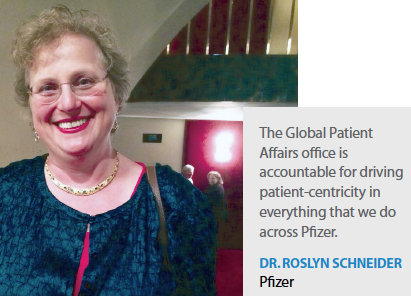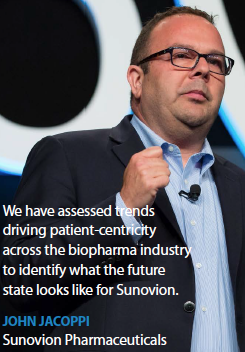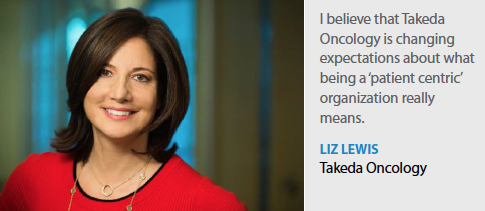With patients taking center stage in discussions around new products, tools, and technologies, it’s not surprising to see so many companies moving the patient to the center of their operational business strategies, starting in the clinic all the way through to commercialization.
Liz Lewis, chief counsel and head of patient advocacy at Takeda Oncology, says her company views the patient as a strategic partner in its business.
“I wear two hats at Takeda Oncology; I’m chief counsel for the organization, and I’m the head of patient advocacy, a  role that I have been passionate about my whole life," she says. “When I was young, I would accompany my father, a physician, on his rounds. There, I would spend time with some of the patients. That experience gave me a deep understanding about the patient experience and what patients need. So often, they want their questions answered and to truly just be heard.
role that I have been passionate about my whole life," she says. “When I was young, I would accompany my father, a physician, on his rounds. There, I would spend time with some of the patients. That experience gave me a deep understanding about the patient experience and what patients need. So often, they want their questions answered and to truly just be heard.
“I would challenge anyone who thinks that means that the role is somehow ‘soft’ or not strategic," she says. “The truth is, this role is just as strategic as my chief counsel role and in fact, they complement each other nicely. To us, the patient is the No. 1 priority and is always at the center when considering decisions and actions. And the values that guide our organization — integrity, honesty, fairness, and perseverance — also guide our relationships not only with patients, but all stakeholders in the health system."
Ms. Lewis says her role as head of patient advocacy and her position on the leadership team is a testament to how highly regarded the patient is within the organization.
“Takeda Oncology is changing expectations about what being a patient-centric organization really means," she says. “We know that by doing right for patients, we do right for the future of drug development. For us, partnering and working with patients and patient organizations is not a check-the-box activity; it’s deeply embedded into our culture," she continues. “Patients are the center of decisions and actions. It defines us as an organization. In my 14-plus years at the company, we have always operated this way. We continue to evolve our work with patients and we have a team that works tirelessly to infuse the patient perspective into all facets of the business, from clinical development to patient support services."
Ms. Lewis cites Takeda Oncology’s “prognostic journey mapping" process as an example as to how the company seeks to understand how patients’ diseases impact their lives and to gather input on Takeda’s clinical trial protocols.
“This process helps identify appropriate inclusion criteria, and the endpoints that matter most to patients," she says. “By shaping clinical studies around patient needs, we can speed recruitment and improve the experience of trial participants. And by working with patient groups to hear about unmet needs, the burdens of current treatments and the patients’ experiences living with cancer, we can tailor their efforts to overcome the daily challenges patients face."
The company is also making strides to understand patients’ real-world experiences living with multiple myeloma.  The result is INSIGHT-MM, a non-interventional, observational, global study of patients with newly diagnosed and relapsed/refractory multiple myeloma. This large study is led by a steering committee of myeloma experts, but a patient is also on the committee. His experience, knowledge, and vote, Ms. Lewis says, has shaped the study design, execution, analysis, and Takeda Oncology’s publication plans.
The result is INSIGHT-MM, a non-interventional, observational, global study of patients with newly diagnosed and relapsed/refractory multiple myeloma. This large study is led by a steering committee of myeloma experts, but a patient is also on the committee. His experience, knowledge, and vote, Ms. Lewis says, has shaped the study design, execution, analysis, and Takeda Oncology’s publication plans.
“Our Multiple Myeloma Patient Leadership Council (PLC) in the United States has enabled a meaningful dialogue between us and our patients — who truly exemplify patient advocacy," she says. “They have opened themselves up to share their experiences and engage in an ongoing dialogue about topics ranging from healthcare delivery and the utilization of value frameworks to patient support programs. Their remit as part of the PLC is honest feedback, which means that they may tell us things that are hard to hear or that we don’t like to hear. But it’s only through that feedback that we are able to learn what we can be doing better and more broadly, where gaps exist in cancer treatment and improvements may be needed. The program has been so valuable in providing important feedback to us in the United States, that we are expanding it globally to ensure we receive honest, robust and geographically/culturally diverse feedback."
At Lexicon Pharmaceuticals, the patient is also center to its initiatives, especially those related to patient opinion leaders and the role they play in the overall ecosystem.
“For years we’ve recognized that patient thought leaders have been the vital bridge between industry and the patients we serve," says Charles “Chas" Schultz, executive director, corporate communications and patient advocacy, Lexicon Pharmaceuticals. “Many are patients themselves and give us crystalline insights about patient and caregiver concerns. Patients often look to them as their champions and advocates and to help them machete their way through the thicket of disease information and reimbursement challenges.
“These expert leaders can also help the pharmaceutical industry with clinical trial design by lending insights into the outcomes measures that really matter to patients," Mr. Schultz continues. “While we tend to look at traditional clinical outcomes, patient opinion leaders have firsthand knowledge about the subtle measures that make patients’ lives better on a day-to-day basis. For instance, in the type one diabetes arena, my company has learned from interviews with community leaders that patients welcome new medications certainly, but, at the same time, hunger for ways to address the far-reaching psycho-social aspects of this disease."
Even as the industry is trying to support health advocates and healthcare thought leaders in tackling the issue of improved physician-patient communications and shared decision-making, Mr. Schultz says a gap remains.
“In fact, a study published in the Journal of the American Medical Association suggests doctors allow patients to speak for a scant 18 seconds before interrupting them," he says. “That’s about 24 words. And the problem is two- sided — with too many patients withholding important information from their healthcare providers, and potentially jeopardizing an accurate diagnosis or treatment recommendation."
sided — with too many patients withholding important information from their healthcare providers, and potentially jeopardizing an accurate diagnosis or treatment recommendation."
While the industry — as well as health advocates and healthcare professionals — strives to educate people, Mr. Schultz says we cannot assume that they all start at the same starting gate.
“We tend to lump all patients together as health consumers, not recognizing that consumers come with varying educational backgrounds, biases, and medical smarts," he adds. “We need to do a better job of customizing learning materials to meet both the sophistication of the patient and his or her desire for objective information. The good news is that technology now allows us to do this. By simply answering a few questions on our websites, and nonprofit sites supported by industry, we can provide bespoke information for the patient that is tailored to his or her level of understanding and desire for depth."
John Jacoppi, executive director, new product planning, Sunovion Pharmaceuticals, says his company is assessing trends driving patient-centricity across the biopharma industry to identify what the future state looks like “We have a five-year initiative, Vision 2020, sponsored by our executive leadership team, which includes a dedicated patient dimension action team that has worked to provide tangible evidence of our goal to become an even more patient-centric organization," he says.
“This includes ensuring that the patient is continually and visibly front and center. The team rolled out patient experience programs for Sunovion’s employees to help put patient-centricity into a common language and to create greater alignment and unity around key priorities of Vision 2020."
Through this program, Sunovion is helping its employees understand patient-centricity. “More importantly, because this is very activity-based training and education, we get employees thinking about their role and how they are ultimately contributing to the patient," Mr. Jacoppi says.
“The content from these training programs is also being incorporated into the organization’s new hire on-boarding program, so that every employee who comes to Sunovion has gone through that initial training and helps bring patient-centricity into our DNA.
“We see patient centricity as a way of thinking, organizing, and working that puts people using healthcare products and services at the center of focus by taking into consideration the individual’s desires, values, goals, circumstances, and lifestyle," he continues. “The patient voice is also being clearly heard during Sunovion’s decision-making process, across the enterprise. Advisory boards that include patient opinion leaders are helping to drive innovative clinical trial design, for example. Teams are also being encouraged to involve patients in the traditional planning process more than ever."
At Pfizer, Roslyn Schneider, MD’s role of global patient affairs lead, was created about four years ago, reporting to the chief medical officer.
“The Global Patient Affairs office is accountable for driving patient’s centricity in everything that we do across Pfizer," she explains. “We are the patient-centricity hub; this is an enterprise-wide function that works to build a foundation of why and how to involve patients in a more meaningful way and more systematically across the organization. We’re testing different models of how to apply or modify patient initiatives based on the desired outcome for patients and for Pfizer. To make this work, we need to have leader support and endorsement at every level across the company, and we have that."
Dr. Schneider says it’s not that patients are more important now than before, because they’ve always been important, but it’s the changing landscape in terms of the roles that patients play in their care and the influence of decisions that affect them.
“Patients are stepping up in different ways and we need to think about the ways that they want to be a part of their care as well as part of the decisions that affect them," she explains. “I will say even when doctors were making house calls way back when, and some still do by the way, patients didn’t feel as if they were partners in their care, and I think that’s the difference that we’re seeing evolve over time. There is a shared decision-making that is advancing in clinical practice and in other decisions that affect the patient community."
Dr. Schneider says Pfizer is taking its existing roadmaps and processes and trying to make sure that patient-centricity is embedded in all of its plans.
“For us, it’s more than making sure that we did the right thing; it’s building the patient into the decision-making process all along the way," she says.
In addition to all of the work Dr. Schneider and her teams are doing internally, she says outside of Pfizer, they are working in a number of coalitions with umbrella advocacy groups, other companies, regulators, and other stakeholders to understand what it means for every entity to be more patient-centered.
“We are contributing to the conversation and then bringing the learnings from what is being created together in these coalitions back to Pfizer so that we can all be learning organizations," she says.
Pharmaceutical companies are not the only organizations that are putting their efforts toward making sure patients are front and center.
Dawie Wessels, MBChB, chief medical officer, at Synexus Clinical Research, says at his company patient-centricity work begins in the local community by engaging with local healthcare professionals (HCP) and patient communities to raise awareness that research is a viable option.
 “We define being patient-centric as placing the patient at the heart of our dedicated global research site strategy and community," Dr. Wessels says. “It is the continued, active listening to patients, to ease the burden of research and increase study compliance and retention. It includes ensuring the end-to-end clinical trial design and experience is inclusive and patient-friendly through the removal of economic and inconvenience barriers. It is about putting the patient first in an open dialogue, to achieve the best experience and outcome for that person and his or her family."
“We define being patient-centric as placing the patient at the heart of our dedicated global research site strategy and community," Dr. Wessels says. “It is the continued, active listening to patients, to ease the burden of research and increase study compliance and retention. It includes ensuring the end-to-end clinical trial design and experience is inclusive and patient-friendly through the removal of economic and inconvenience barriers. It is about putting the patient first in an open dialogue, to achieve the best experience and outcome for that person and his or her family."
He says the path to patient-centricity started with a commitment to increase local HCP and patient involvement in clinical trials.
“Fewer than 20% of patients are aware that research is an option," Dr. Wessels says. “At the same time, HCPs refer just 0.2% of their patients to research studies."
To ensure patient centricity, Synexus heavily invests in patient activation activities, such as its Patient Retention Social Events that have been conducted in its Stanza Clinical Research Centre in Mamelodi, South Africa.
At Remedy Health Media, CEO Michael Cunnion says at its heart, being patient-centric is simply putting the patient first — and actively taking the steps to ensure that all inner workings of a relationship between a third-party and a patient are designed to support the patients’ needs, wants, and wellbeing.
“Everything that we do here at Remedy Health Media revolves around this very concept," he says. “We are focused on inspiring patients to live boldly in their pursuit of better health, and we do that by providing real-life, video patient stories in an emotionally inspiring way. Our digital brands inspire millions of patients and caregivers to live healthier and more fulfilled lives. Our mission is to inspire patients and caregivers with the information and applications needed to efficiently navigate the healthcare landscape and as a result, to permit better health outcomes.
“We engage with patients to shape strategies in a variety of ways — through Remedy’s digital brands such as HealthCentral and The Body, as well as through long-standing partnerships with renowned universities, including the University of California, Berkeley, School of Public Health, and even through collaborations with medical institutions and non-profit health organizations," Mr. Cunnion continues. “We also turn to our patient health experts and influential social ambassadors who have an insider’s view of the condition communities they are a part of." (PV)


















